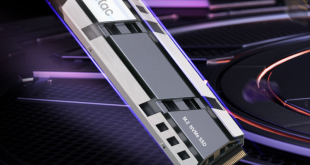The Asus Matrix HD7970 Platinum arrives in a predominately red box which features Republic Of Gamers artwork. No high resolution picture of the card on the front of the box however.
The box is a gatefold design which opens up to expose the Asus Matrix HD7970 Platinum in all its glory. There are a list of key specifications on the other side of the box, some of which we discussed on the previous page.
Inside the box is a very strong bundle, featuring a Crossfire cable, video and power converter cables, an ASUS chassis sticker, software/driver disc and a VRM heatsink specifically designed for liquid nitrogen overclocking. ASUS also bundle a soft, small Diablo III mousemat.
The Matrix HD7970 Platinum graphics card is a beast. It is a triple slot cooler design with a backplate on the PCB to help improve cooling efficiency. The Asus branded twin fans are set above the heatsink.
The Asus Matrix HD7970 Platinum is Crossfire capable in 2, 3 and 4 way configurations.
It demands power from two 8 Pin PCI E power cables. In theory this card could demand up to 375W of power.
In their literature ASUS claim this card is 2.6 slots, but in the real world that means 3 slots. It measures 11 inch x 5.1 inch x 2.1 inch.
On the rear of the card are two DVI ports and 4 Displayports – it is fully EyeFinity capable.
Unless you are trying to break records, the cooler takes around 10 minutes to remove carefully. There are plates on both the rear and front of the PCB. These are removed with screws on both the underside of the card and on the I/O panel at the back. The backplate has little rubber spacers glued to each screw hole to ensure that the plate does not make direct contact with the PCB.
The front plate is removed with the screws, and underneath are thermal pads which help reduce the temperatures of the memory and VRM's scattered across the board.
The PCB has three buttons – one for safe posting, and the others to decrease and increase the voltage. There is a red button close by which is used to maximise the fan speeds, outside software control. This particular board uses high grade Hynix GDDR5 memory.
The Matrix HD7970 has a huge 20 phase power delivery system, which helps ensure stability at high overclocked speeds. ASUS are using hardened Super Allow Power Capacitors, chokes and MOSFETs. This should help increase board life and eliminate choke buzzing noise.
The cooler comprises five thick 8mm heatpipes, two of which bend back on themselves into one rack of aluminum fins. The other three are arranged in parallel to disperse as much heat as possible from the copper core block offset to the left.
There are two fan headers on the Asus Matrix HD7970 Platinum which attach to individual ports on the card. If you take the card apart be sure to make sure they are both attached.
An overview of the Asus Matrix HD7970 Platinum in GPUz. As discussed earlier, the Tahiti core is based on the 28nm manufacturing process and comprises 4.31 billion transistors. The 3GB of GDDR5 is connected via a wide 384 bit memory interface. The core is overclocked to 1,100mhz and the memory to 1,650mhz (6.6Gbps effective). The card has dual geometry engines, eight render back ends, 2048 unified shaders, 32 color ROPs per clock and 128 Z/stencil ROPs per clock. A powerful card and AMD's current flagship model.
 KitGuru KitGuru.net – Tech News | Hardware News | Hardware Reviews | IOS | Mobile | Gaming | Graphics Cards
KitGuru KitGuru.net – Tech News | Hardware News | Hardware Reviews | IOS | Mobile | Gaming | Graphics Cards























Thats another beautiful card for AMD. Quite a few really high end, loaded boards for 7970 lovers.
Good review thanks.
ASUS deserve a lot of credit for this – I love it when companies go nuts on the design for the high end audience. Im tempted to go for this later in the year, but I agree – the Sapphire HD7970 6GB Toxic Edition looks to be a slightly better deal all round.
Zardon – top review bro. I still think the GTX680 is the best value for money high end card on the market however. you can pick up a killer one for £380
Im not a fan of triple slot coolers – I think in this case it has helped ASUS lower the noise levels which is welcomed, but they are huge cards and take up so much space in a case. I think Sapphire 6GB Toxic is still the best, but the extramemory really isn’t needed for most people/situations